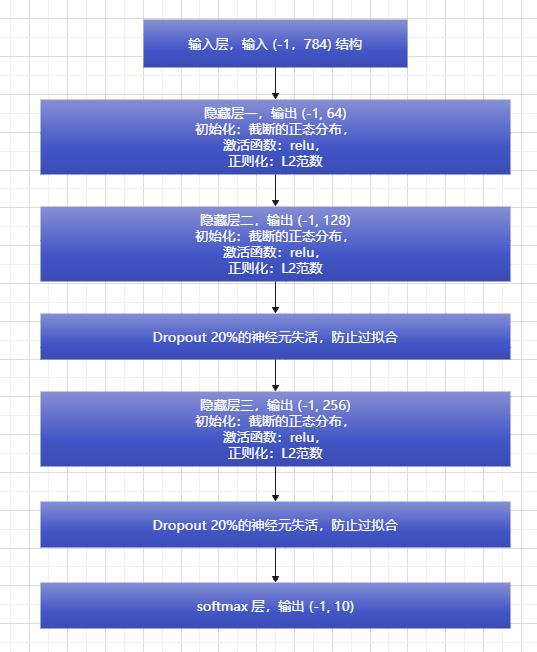基于 Tensorflow 2.x 实现 BP 神经网络,实践 MNIST 手写数字识别
Posted 小毕超
tags:
篇首语:本文由小常识网(cha138.com)小编为大家整理,主要介绍了基于 Tensorflow 2.x 实现 BP 神经网络,实践 MNIST 手写数字识别相关的知识,希望对你有一定的参考价值。
一、MNIST 数据集
MNIST 是一个非常有名的手写数字识别数据集,在很多资料中都会被用作深度学习的入门样例。在 Tensorflow 2.x 中该数据集已被封装在了 tf.keras.datasets 工具包下,如果没有指定数据集的位置,并先前也没有使用过,会自动联网下载该,使该数据集使用起来更加方便,它包括了 70000 张图片数据,大小统一是 28x28的长宽,其中 60000 张作为训练数据,10000张作为测试数据,每一张图片都代表 0~9 中的一个数字,可以通过下面程序对该数据进行可视化预览:
import tensorflow as tf
import matplotlib.pyplot as plt
keras = tf.keras
mnist = tf.keras.datasets.mnist
plt.rcParams['font.sans-serif'] = ['SimHei']
# 加载 fashion_mnist 数据集
(x_train, y_train), (x_test, y_test) = mnist.load_data()
print(x_train.shape, y_train.shape, x_test.shape, y_test.shape)
for i in range(10):
image = x_test[i]
label = y_test[i]
plt.imshow(image, cmap=plt.cm.gray)
plt.title(label=('标签值: ' + str(label)))
plt.show()
运行后可以看下如下的图片示例:

二、搭建多层BP神经网络模型
本文基于 Tensorflow 2.x 构建 BP 神经网络,在 Tensorflow 2.x 中官方更推荐的上层API工具为 Keras ,本文也是使用 Keras 进行实验测试。
设计模型结构如下所示:

通过 Keras 建立模型结构,具体的解释都写在了注释中:
import tensorflow as tf
keras = tf.keras
mnist = tf.keras.datasets.mnist
# 定义模型类
class mnistModel():
# 初始化结构
def __init__(self, checkpoint_path, log_path, model_path):
# checkpoint 权重保存地址
self.checkpoint_path = checkpoint_path
# 训练日志保存地址
self.log_path = log_path
# 训练模型保存地址:
self.model_path = model_path
# 初始化模型结构
self.model = tf.keras.models.Sequential([
# 输入层,平坦层,输入 (None, 784)
tf.keras.layers.Flatten(input_shape=(28, 28)),
# 隐藏层 一 ,输出 (None, 64)
tf.keras.layers.Dense(64,
kernel_initializer=keras.initializers.truncated_normal(stddev=0.05),
activation=tf.nn.relu,
kernel_regularizer=keras.regularizers.l2(0.001)),
# 隐藏层 二 ,输出(None, 128)
tf.keras.layers.Dense(128,
kernel_initializer=keras.initializers.truncated_normal(stddev=0.05),
activation=tf.nn.relu,
kernel_regularizer=keras.regularizers.l2(0.001)),
# Dropout 随机失活,防止过拟合,20%的神经元失活,输出 (None, 128)
tf.keras.layers.Dropout(0.2),
# 隐藏层 三 ,输出 (None, 256)
tf.keras.layers.Dense(256,
kernel_initializer=keras.initializers.truncated_normal(stddev=0.05),
activation=tf.nn.relu,
kernel_regularizer=keras.regularizers.l2(0.001)),
# Dropout 随机失活,防止过拟合,20%的神经元失活,输出 (None, 254)
tf.keras.layers.Dropout(0.2),
# softmax 层,输出 (None, 10)
tf.keras.layers.Dense(10, activation='softmax')
])
# 编译模型
def compile(self):
# 输出模型摘要
self.model.summary()
# 定义训练模式
self.model.compile(optimizer='adam',
loss='sparse_categorical_crossentropy',
metrics=['accuracy'])
# 训练模型
def train(self, x_train, y_train):
# tensorboard 训练日志收集
tensorboard = keras.callbacks.TensorBoard(log_dir=self.log_path)
# 训练过程保存 Checkpoint 权重,防止意外停止后可以继续训练
model_checkpoint = keras.callbacks.ModelCheckpoint(self.checkpoint_path, # 保存模型的路径
monitor='val_loss', # 被监测的数据。
verbose=0, # 详细信息模式,0 或者 1
save_best_only=True, # 如果 True, 被监测数据的最佳模型就不会被覆盖
save_weights_only=True,
# 如果 True,那么只有模型的权重会被保存 (model.save_weights(filepath)),否则的话,整个模型会被保存,(model.save(filepath))
mode='auto',
# auto, min, max的其中之一。 如果 save_best_only=True,那么是否覆盖保存文件的决定就取决于被监测数据的最大或者最小值。 对于 val_acc,模式就会是 max,而对于 val_loss,模式就需要是 min,等等。 在 auto模式中,方向会自动从被监测的数据的名字中判断出来。
period=3 # 每3个epoch保存一次权重
)
# 填充数据,迭代训练
self.model.fit(
x_train, # 训练集
y_train, # 训练集的标签
validation_split=0.2, # 验证集的比例
epochs=30, # 迭代周期
batch_size=30, # 一批次输入的大小
verbose=2, # 训练过程的日志信息显示,一个epoch输出一行记录
callbacks=[tensorboard, model_checkpoint]
)
# 保存训练模型
self.model.save(self.model_path)
def evaluate(self, x_test, y_test):
# 评估模型
test_loss, test_acc = self.model.evaluate(x_test, y_test)
return test_loss, test_acc
上面优化器使用的 adam,loss 为 sparse_categorical_crossentropy,一共训练 30 个周期,每个 batch 30 张图片,验证集的比例为 20%,并且每三个周期保存一次权重,防止意外停止后继续训练,最后保存了 h5 的训练模型,方便后面进行测试预测效果。
下面开始训练模型:
import tensorflow as tf
keras = tf.keras
mnist = tf.keras.datasets.mnist
def main():
# 加载 MNIST 数据集
(x_train, y_train), (x_test, y_test) = mnist.load_data(path='F:/Tensorflow/datasets/mnist.npz')
# 修改shape 数据归一化
x_train, x_test = x_train / 255.0, x_test / 255.0
checkpoint_path = './checkout/'
log_path = './log'
model_path = './model/model.h5'
# 构建模型
model = mnistModel(checkpoint_path, log_path, model_path)
# 编译模型
model.compile()
# 训练模型
model.train(x_train, y_train)
# 评估模型
test_loss, test_acc = model.evaluate(x_test, y_test)
print(test_loss, test_acc)
if __name__ == '__main__':
main()
运行后可以看到网络结构:

训练日志,可以看到 loss 一直在减小:

最后看下评估模型的结果:

毕竟是BP神经网络,这里评估的准确率只有 96.8 %,在本专栏后面博客,会使用多层卷积训练模型,可以实现更好的效果。
下面看下 tensorboard 中可视化的损失及准确率:
tensorboard --logdir=log/train

使用浏览器访问:http://localhost:6006/ 查看结果:

三、模型预测
上面搭建的模型,训练后会在 model 下生成 model.h5 模型,下面直接加载该模型进行预测:
import tensorflow as tf
import matplotlib.pyplot as plt
keras = tf.keras
mnist = tf.keras.datasets.mnist
plt.rcParams['font.sans-serif'] = ['SimHei']
# 加载 MNIST 数据集
(x_train, y_train), (x_test, y_test) = mnist.load_data()
# 数据归一化
x_train, x_test = x_train / 255.0, x_test / 255.0
model = keras.models.load_model('./model/model.h5')
for i in range(10):
image = x_test[i]
label = y_test[i]
softmax = model.predict(image.reshape([1, 784]))
y_label = tf.argmax(softmax, axis=1).numpy()[0]
plt.imshow(image, cmap=plt.cm.gray)
plt.title(label = ('预测结果: '+ str(y_label) + ', 真实结果: '+ str(label)))
plt.show()
运行后可以看下如下的图片示例:

可以看到面对书写较工整的数字都可以较好的进行识别,但是对于不工整的就有点吃力,下一篇使用卷积神经网络进行优化,提高识别的准确率。
以上是关于基于 Tensorflow 2.x 实现 BP 神经网络,实践 MNIST 手写数字识别的主要内容,如果未能解决你的问题,请参考以下文章
基于 Tensorflow 2.x 实现 BP 神经网络,实践 MNIST 手写数字识别
基于 Tensorflow 2.x 实现多层卷积神经网络,实践 MNIST 手写数字识别
基于 Tensorflow 2.x 实现多层卷积神经网络,实践 MNIST 手写数字识别
基于 Tensorflow 2.x 实现多层卷积神经网络,实践 MNIST 手写数字识别